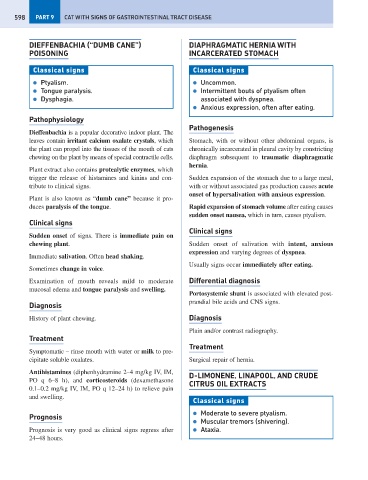Page 606 - Problem-Based Feline Medicine
P. 606
598 PART 9 CAT WITH SIGNS OF GASTROINTESTINAL TRACT DISEASE
DIEFFENBACHIA (“DUMB CANE”) DIAPHRAGMATIC HERNIA WITH
POISONING INCARCERATED STOMACH
Classical signs Classical signs
● Ptyalism. ● Uncommon.
● Tongue paralysis. ● Intermittent bouts of ptyalism often
● Dysphagia. associated with dyspnea.
● Anxious expression, often after eating.
Pathophysiology
Pathogenesis
Dieffenbachia is a popular decorative indoor plant. The
leaves contain irritant calcium oxalate crystals, which Stomach, with or without other abdominal organs, is
the plant can propel into the tissues of the mouth of cats chronically incarcerated in pleural cavity by constricting
chewing on the plant by means of special contractile cells. diaphragm subsequent to traumatic diaphragmatic
hernia.
Plant extract also contains protealytic enzymes, which
trigger the release of histamines and kinins and con- Sudden expansion of the stomach due to a large meal,
tribute to clinical signs. with or without associated gas production causes acute
onset of hypersalivation with anxious expression.
Plant is also known as “dumb cane” because it pro-
duces paralysis of the tongue. Rapid expansion of stomach volume after eating causes
sudden onset nausea, which in turn, causes ptyalism.
Clinical signs
Clinical signs
Sudden onset of signs. There is immediate pain on
chewing plant. Sudden onset of salivation with intent, anxious
expression and varying degrees of dyspnea.
Immediate salivation. Often head shaking.
Usually signs occur immediately after eating.
Sometimes change in voice.
Examination of mouth reveals mild to moderate Differential diagnosis
mucosal edema and tongue paralysis and swelling.
Portosystemic shunt is associated with elevated post-
prandial bile acids and CNS signs.
Diagnosis
History of plant chewing. Diagnosis
Plain and/or contrast radiography.
Treatment
Treatment
Symptomatic – rinse mouth with water or milk to pre-
cipitate soluble oxalates. Surgical repair of hernia.
Antihistamines (diphenhydramine 2–4 mg/kg IV, IM,
D-LIMONENE, LINAPOOL, AND CRUDE
PO q 6–8 h), and corticosteroids (dexamethasone
CITRUS OIL EXTRACTS
0.1–0.2 mg/kg IV, IM, PO q 12–24 h) to relieve pain
and swelling.
Classical signs
● Moderate to severe ptyalism.
Prognosis
● Muscular tremors (shivering).
Prognosis is very good as clinical signs regress after ● Ataxia.
24–48 hours.

